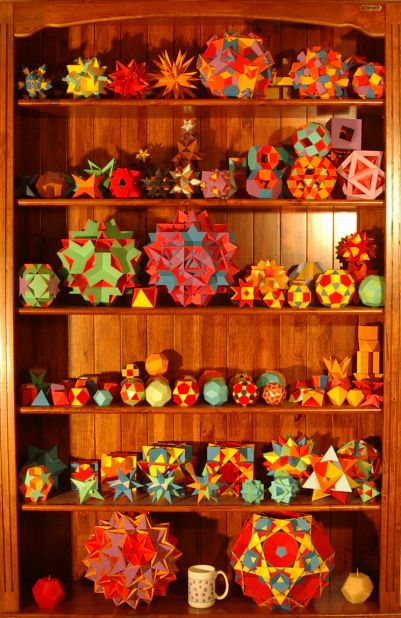
|
This paper was published in the second special polyhedron issue of the
Symmetry: Culture and Science journal
(see contents).
The journal was released in 2004, but backdated to 2002 for some reason, so if
you wish to reference this article, the reference might read:
Webb, Robert "Stella Models", Symmetry: Culture and Science, Vol. 13, Nos. 3-4, p391-399, 2002 (available online at http://www.software3d.com/StellaModels/StellaModels.php) |
Abstract: In the first Polyhedra issue of Symmetry: Culture and Science, I presented the paper Stella: Polyhedron Navigator [4] which described the Great Stella software package [5] for creating, viewing and printing nets for a wide range of polyhedra. Now I present a collection of paper models constructed using nets printed by this software.
Before making a model, it is first created and viewed on the computer screen in Great Stella. Many of the models presented here are already built into Stella (all of the uniform polyhedra and Stewart toroids for example), so creation involves no more than selecting them from the list of built-in models. Some others are provided in a polyhedron library included with Great Stella, and the rest were created using Stella's various polyhedral creation tools such as stellation, faceting or augmentation. The term trillions would hardly do justice to the number of polyhedra that could be created in Stella, so the models presented here represent only a very small sample of what's possible.
Once the model is on the screen, Stella can generate and print nets for it. The models shown here were all made by printing nets directly onto the paper that will be used to build the model (about 50% thicker than standard printing paper). I mostly use coloured paper, and Stella's "One Colour per Net" option which makes sure parts of different colours are never put into the same nets. It also groups nets of the same colour together onto pages, and only prints pages of one colour at a time.
Figure 1 shows a bookcase containing all the paper models I have constructed using nets from Stella. You'll have trouble identifying them all though, due to size and the fact that many are hidden behind others. But it is nice to see the whole set together. The mug on the bottom shelf has a polyhedral design on it, so it is not entirely out of place.
 |
Figure 2 shows a collection of uniform polyhedra, which should be familiar to most polyhedral enthusiasts. Figures 3 and 4 show two more uniform polyhedra, the amazing great dirhombicosidodecahedron, also known as "Miller's Monster", and the great icosicosidodecahedron.
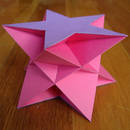 |
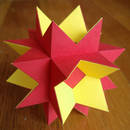 |
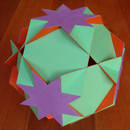 |
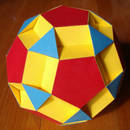 |
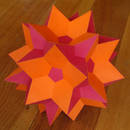 |
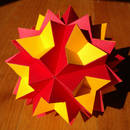 |
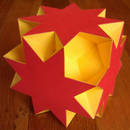 |
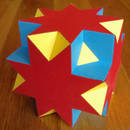 |
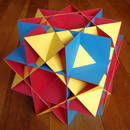 |
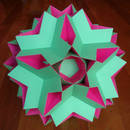 |
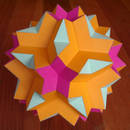 |
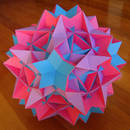 |
 |
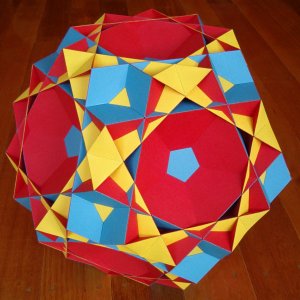 |
Figure 5 shows a collection of stellations. Figures 5a and 5b are stellations of the icosahedron, as presented in The Fifty-Nine Icosahedra [1]. Figures 5c through 5f are stellations of various duals of Archimedean solids. Figure 5g may be considered a stellation of the snub cube. It is a cube with a snub cube shaped hole inside it. The rest are stellations of various nonconvex uniform polyhedra.
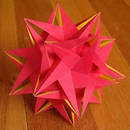 |
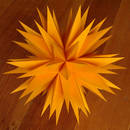 |
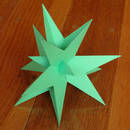 |
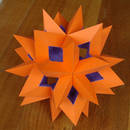 |
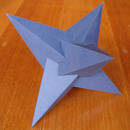 |
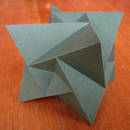 |
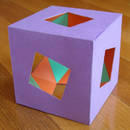 |
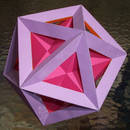 |
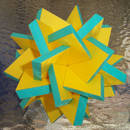 |
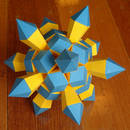 |
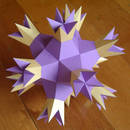 |
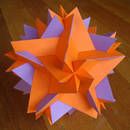 |
Figure 6 is a set of compounds. Stella does not yet have a specific tool for creating compounds as such (although this is planned for a future version), but many compounds can still be created using the other built-in tools. Here we see some examples. Figure 6a is a compound of four tetrahedra, with tetrahedral symmetry overall too. Figure 6b is a compound of two small stellated dodecahedra, having octahedral symmetry overall. Figures 6c and 6d are compounds of three and four cubes respectively, each with octahedral symmetry. Figure 6e is a compound of five dodecahedra while 6f is a compound of five small stellated dodecahedra, and may be thought of as a stellation of the 6e. They each have icosahedral symmetry.
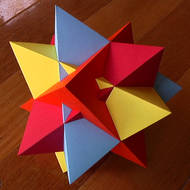 |
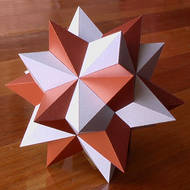 |
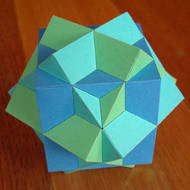 |
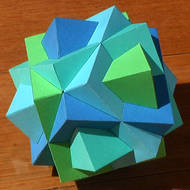 |
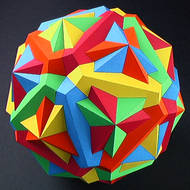 |
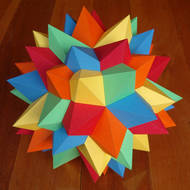 |
Figure 7 shows some more compounds, but these are all compounds of 15 rectangular prisms. Each is a faceting of a different Archimedean solid, that is, they share the same set of vertices, and were created using Stella's faceting mode. The 15 prisms fall into five sets of three, each prism having all faces parallel to other prisms in the same set. An infinite continuum of such compounds exists. When the prisms become cubes, members of each set coincide, giving the familiar compound of five cubes, a faceting of the dodecahedron. Despite these models having so much in common, they each have a very different flavour.
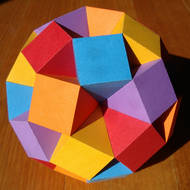 |
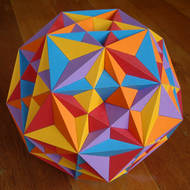 |
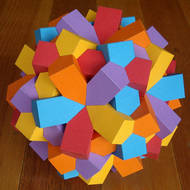 |
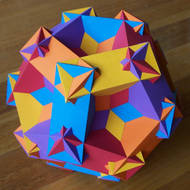 |
Figure 8 presents a sample of Stewart toroids as originally investigated in "Adventures Among the Toroids" [3]. All faces are regular and non-intersecting. Figure 8f shows the model in 8e at an earlier stage in construction, allowing you to see what's going on in the centre. The external shell is the Archimedean truncated icosidodecahedron. This has pentagonal rotundas excavated from the decagonal faces, then a rhombicosidodecahedron excavated from the centre. Figure 8f lets you see the latter model's square and triangular faces from inside. Figure 8c shows a new type of Stewart toroid that was discovered by Alex Doskey [2]. See his paper elsewhere in this journal for further details.
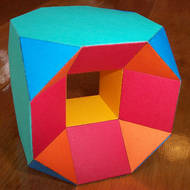 |
 |
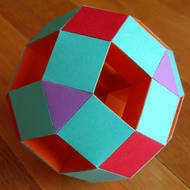 |
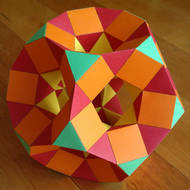 |
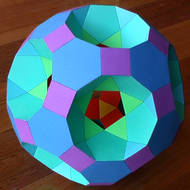 |
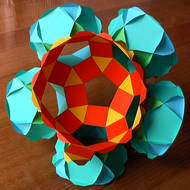 |
Finally, figure 9 shows some miscellaneous polyhedra that didn't fit well into the other categories. Figure 9a is the bilunabirotunda, one of the 92 Johnson solids (J91). It is the only model presented here whose nets (or single net in this case) were printed in colour onto white paper, rather than just as an outline onto coloured paper. Figure 9b is a crossed square cupola. The Johnson solids and various cupolae are all built into Stella. Figure 9c is a sub-symmetric stellation of the dodecahedron, while 9d is a sub-symmetric faceting of the cube. Figure 9e shows a great cubicuboctahedron that has been augmented with pyramids on each of its square faces, creating a kind of nonconvex Johnson solid. And last but not least, 9f is a pseudo great rhombicuboctahedron. The great rhombicuboctahedron is uniform, but this is another polyhedron which is "locally" uniform. Each vertex is equivalent if you only consider its surrounding faces, rather than its relationship to the model as a whole. Compare this to figure 2i which shows the uniform version.
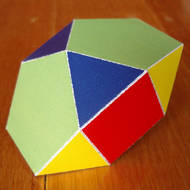 |
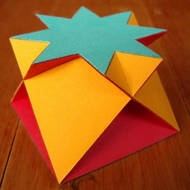 |
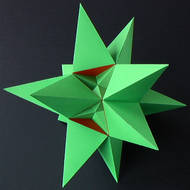 |
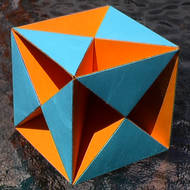 |
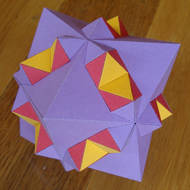 |
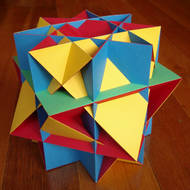 |
I hope this presentation has been enjoyable. There are still many more interesting polyhedra to build, including old favourites, recent discoveries, and more gems yet to be found. As you can see, I will need a new bookcase soon!